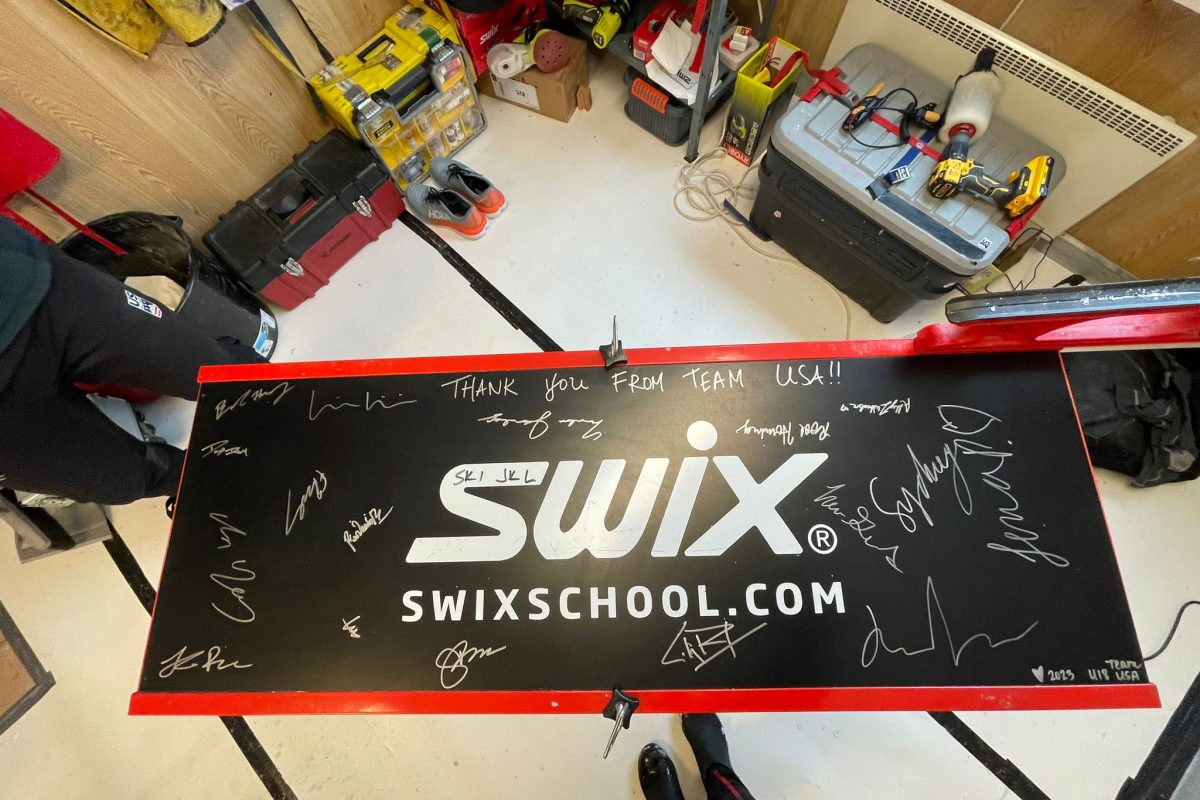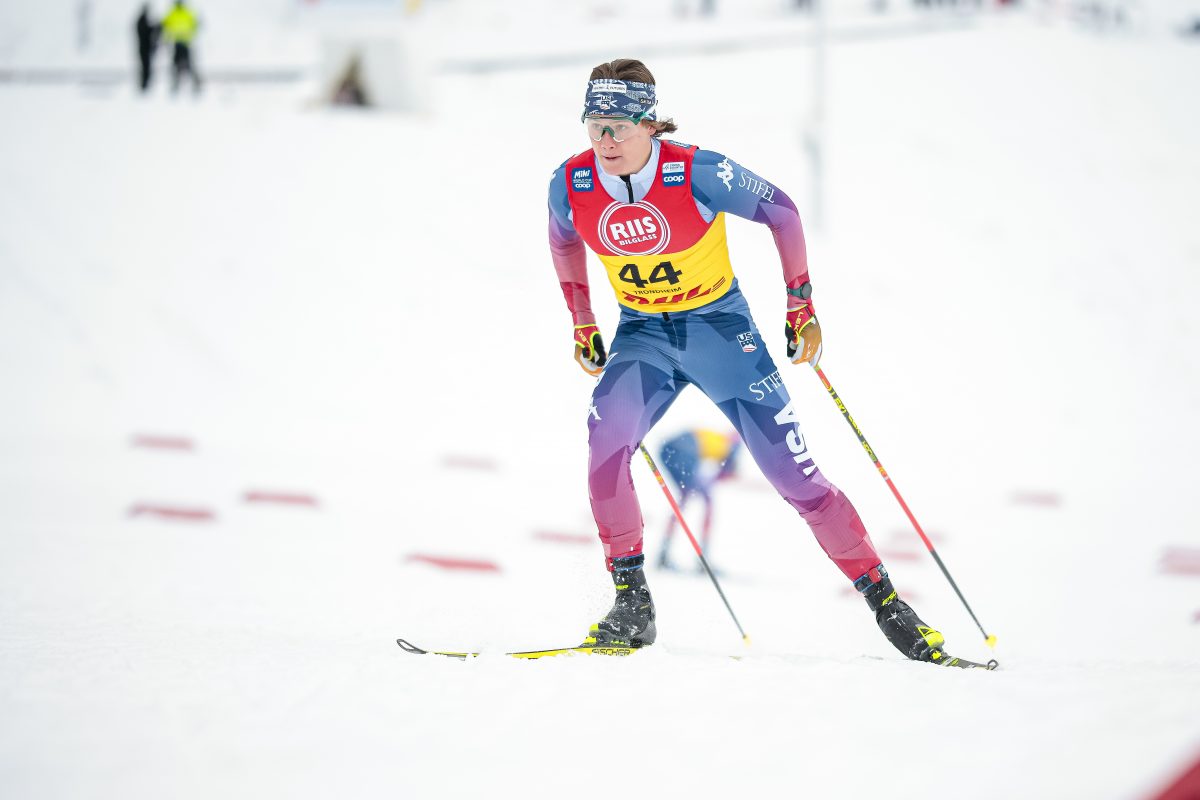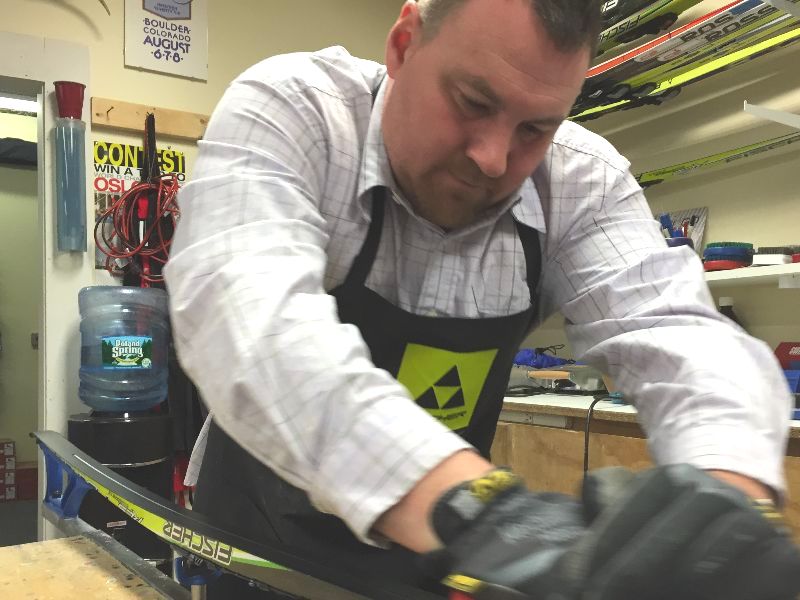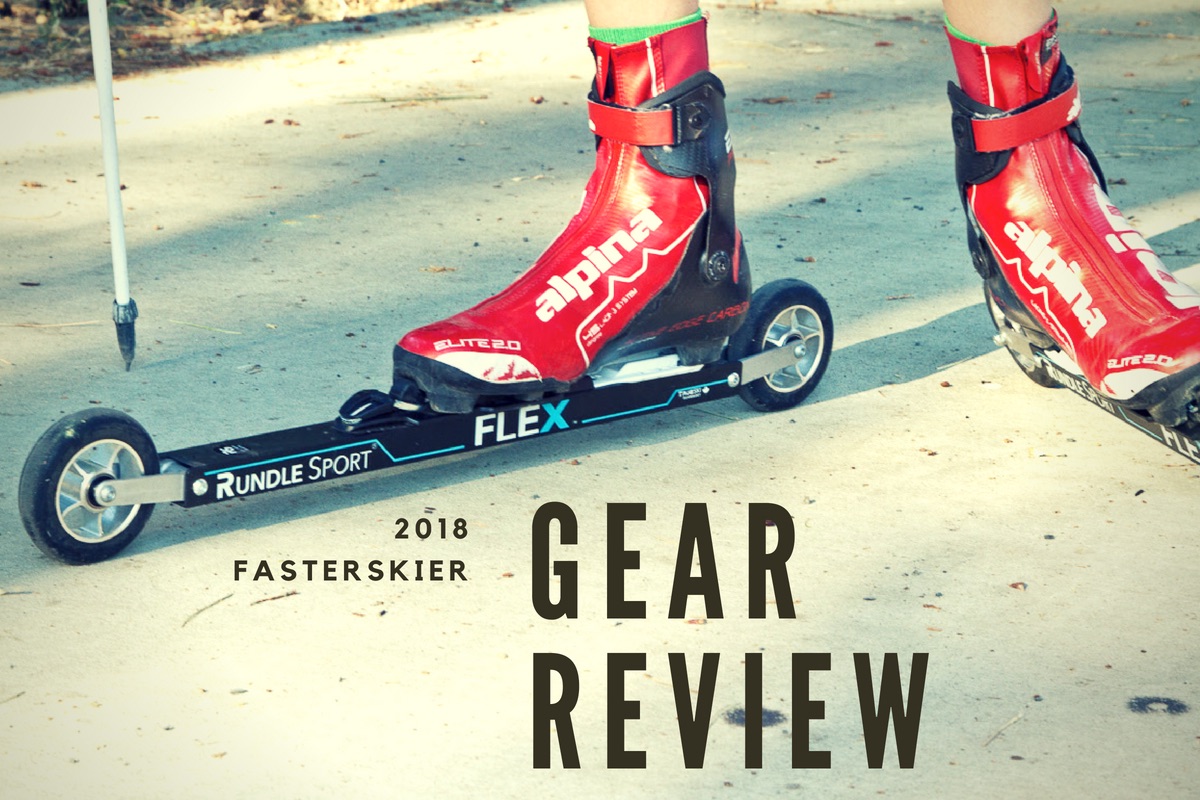
With the evolution from aluminum-shaft rollerskis to composite laminates (think a combination of wood, sometimes a honeycomb matrix and layers of fiberglass/carbon fiber) manufacturers have built rollerskis with “flex”. A skate rollerski’s flex pattern is part of the design process to better mimic that ubiquitous “on-snow feel” nearly all rollerki manufacturers claim and few master.
For the purposes of this review, “on-snow feel” for rollerskis will be defined as the following: smooth, relative vibration-free sensations while in the glide phase. Add a slight “flex” under foot during the glide phase for good measure and dash of return energy on the push off.
The “flex” underfoot makes it more like real skiing. During real on-snow skiing, a ski’s camber, or curved shape, begins to flatten out against the snow when weighted. Many skate rollerski manufacturers try to recreate the sensations of loading and unloading a ski while skate skiing on snow. In other words, the rollerski is dynamic under load.
So back to the pavement and the mythical and over-marketed “on-snow feel”. Skate rollerskis range from those feeling like a rollerblade to highly engineered, skate-ski-like-camber aspirants.
The “on-snow feel” is very much an on-pavement feel for the rollerblade end of the spectrum. Short, aluminum-shaft rollerskis trend towards a “buzzy” quality under foot on less-than-ideal pavement. Little of the road noise is dampened. And the rigidness of shorter aluminum shafts allows for no discernible flex under load. The feedback and response from the push-off phase is immediate. That’s great for an efficient rollerblade-type experience. If you skate ski on stiff boards and boilerplate, and that puts a smile on your face, then maybe that’s the “on-snow feel” experience you’re looking for.

There are, however, a few options for skate rollerskiing where boilerplate will be far from the mind. For the past few years, several companies have created rollerski fork systems that flex at the front and rear forks independently. Most notable here in North America are two different brands: the Pursuit Fork Flex skate rollerskis (sold by rollerskishop.com) and an offering from Rundle Sport based in Canmore, Alberta. In this review, we’ll drill down on Rundle Sport’s latest FLEX skate rollerski. (Rundle Sport is an advertiser on FasterSkier.) The parts for their FLEX skate rollerski are sourced internationally and assembled in Canada.
The Rundle Sport FLEX has been updated since the 2016 model was released. The aluminum shaft has has been lengthened for a longer wheelbase. The older version ran 580 millimeters, center wheel to center wheel. The updated version stretches 610 mm. (We’ll get to how this impacts the rollerski experience in a bit.) For comparison, Marwe’s top of line skate rollerski measures 620 mm, the equivalent Swenor 615 mm.
The wheels are standard 100 mm x 24 mm. They, too, are updated and are a standard #2 speed wheel sourced from Serbia (where many leading brands source their wheels) and are comparable in speed to Marwe and Swenor #2 wheels.
The FLEX comes with front and rear fenders for those wet days.

Most notably, the aluminum forks have been redesigned. The old model’s forks created what looked like a barely noticeable drop from the wheel center to the shaft’s bottom edge. Using the same size wheels, 100 mm x 24 mm, the older model sat higher off the ground than many rollerskis when unweighted.
The new forks allow for a full 7mm drop. As a result, the newer model rests 30 mm off the pavement unweighted. That lower off-the-deck height makes for a solid and stable rollerski experience. That stability is most evident during the V2 glide phase while bleeding speed before the push off. Which is to say the newest version of the FLEX won’t throw instability into the mix if you’re a beginner rollerskier.
I have been on the older FLEX model for two years. In that time, instability was not an issue. Yet while using the old and new models simultaneously, the newer model’s lower running surface coupled with its slightly longer shaft feels more secure. Less like you’re balancing on two wheels and more like there’s a ski underfoot. It’s a case of not knowing an alternative might be better until presented with a different option. The Rundle Sport engineers in Canmore received feedback that the older models were a bit tippy. They evolved their thinking and designed the 7 mm drop fork. Rundle Sport offers a fork retrofit for older models by making the new forks available for purchase separately.

What was true of the older model FLEX is true of the 2018 version. The suspension system, which is basically a pivoting fork that compresses a rubber dampener, makes rougher pavement tolerable. We’re not talking alchemy here, as in a miraculous smoothness on gnarly chip and seal. But, no doubt when the FLEX folks boast their product reduces vibrations — it’s the truth. (Here’s a link to Rundle Sport’s own vibration test. You’ll need to scroll down a bit.)
The Nitty Gritty:
Rundle Sport FLEX Skate Rollerski:
– Cost: $400 CND
– Weight/pair (without binding): 1850 g/pair
– Wheel size (width / diameter): approx. 24 mm x 100 mm
– Wheel speed: #2
– Effective length (center wheel to center wheel): 610 mm
– Height (bottom edge of the shaft to the ground when unweighted): 30 mm
On less-than-butter-smooth pavement, it allows for long rollerski loops while still being able to focus on technique rather than vibration-trashed feet. For athletes who like variety, depending on where you live, an unadvertised benefit to the FLEX is that it might open up more paved terrain.
Testing the new version of the FLEX is much like the older version: they feel more like a ski that compresses under load. The amount of flex at the interface of the fork and shaft can be fine tuned with Rundle Sport’s color coded rubber dampeners. (The dampeners are easily changed, yet when ordering a pair, Rundle Sport will ask for the skier’s weight.)
- Blue (less than 120 lbs or less than 55 kg)
- Orange (121-150 lbs or 55-68kg)
- Purple (151-180 lbs or 69-81 kg)
- Black (181 lbs or more or 82 kg or more)
I rollerskied on the purple dampeners for three weeks and then began experimenting with orange dampeners on one ski, purple on the other. I weigh approximately 158 pounds (always round down) so I fall on the light side of the purple dampeners, and the heavy side for the orange.
Under full weight, as expected, the ski with orange dampeners flexed slightly more than the purple-dampener ski. Yet both skis could be described as smooth and responsive. On both skis, vibration reduction was noticeable on poorer pavement. I really did not prefer one dampener set over the other. Yet, if I had higher fidelity to more active and energetic skiing, the purple dampeners would be the go-to. (It takes approximately five minutes per ski to swap out dampeners.)

On smooth black top, the rollerskis shine. It is there that one can ski actively and feel the response of the FLEX’s high-camber like properties. Compress the FLEX rollerski and there’s no immediate force back into the knees and hips as one might find on overly stiff aluminum or composite rollerskis. It’s a smoother transition from the load to glide to push off.
The FLEX feel comfortable and easier on the body. Something this aging skier appreciates.
Again, I’ve been on a suspension rollerski for two years. Sure, it is interesting demoing rollerskis. But after that much time skiing on pavement with skate-ski-like flex on a rollerski, I have a tough time convincing the brain and body I could go back. As far as weight without bindings, the updated FLEX are 1850 gm/pair.
Technical cornering, speeding downhill, and tracking were non-issues with the updated FLEX skis. During a 2016 review of the FLEX, I experienced what I would call a wandering ski during high-speed downhills. One of the two rollerskis would drift outward and I found myself being vigilant to keep the rollerskis shoulder width apart. Maybe that was due to the higher shaft height of the older model or its shorter length. Either way, there was no drifting on the same hills at comparable speeds using the newer version of the FLEX rollerski. They tracked straight with no deviations over the duration of the testing period.

That brings us to the new longer shaft. I realize now I was a sucker for the shorter shaft length. Less rollerski just seemed more efficient and playful. Three centimeters might not be much, and it’s not. But the longer FLEX shaft is noticeable in a key department. The longer shaft, and thus longer wheelbase, make for a more ski-like platform when pushing off.
We foresee no durability issues in the long term for the new FLEX model. In the two years I’ve been on the older FLEX model, I replaced all four wheels once. Admittedly, I was less than vigilant in those two years about swapping the left and right skis to prevent uneven wear. (Currently, Rundle Sport sources wheels for the new FLEX model from a different manufacturer as the stock wheels on the 2016 FLEX model.) On my personal 2016 pair, the forks, dampeners and shafts are original vintage. They have been abused by a curb-hucking teenager and have no evident signs of wear besides normal scuffing on the shaft. Nothing beyond the wheels have been replaced. The newer 2018 forks, dampeners, and shafts are manufactured to the same quality standards.
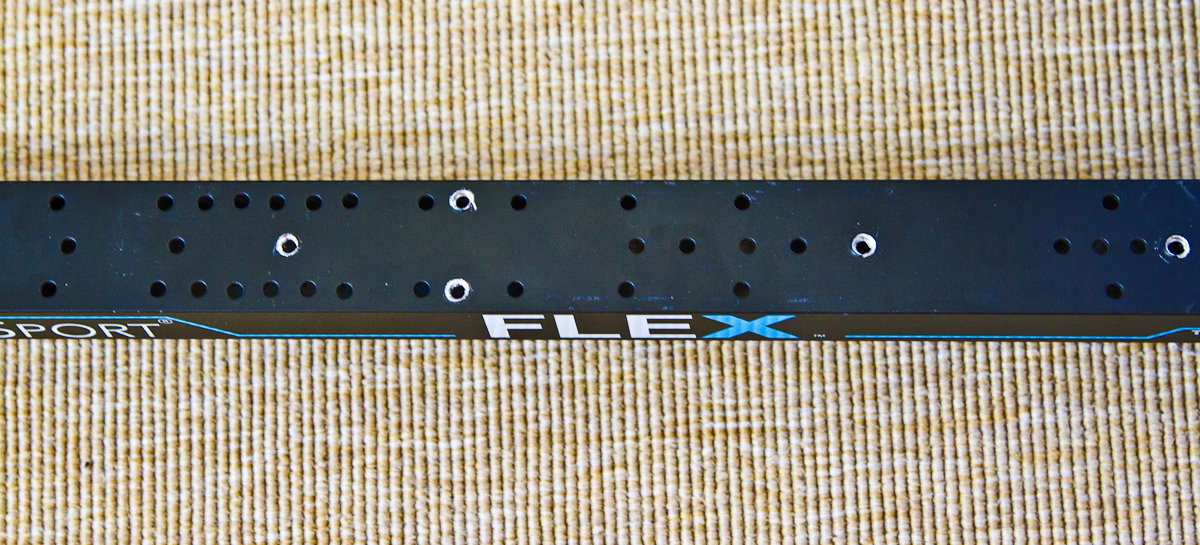
The updated shaft comes pre-drilled for both SNS/Prolink, NNN, NIS, and Rottefella’s rollerski binding. If you’re a skier who experiments with binding placement, it’s possible to mount bindings in different positions to accommodate different size boots and rollerski feel.
Here are the relative number of binding positions for each specific binding type:
- SNS: 2 positions
- NIS: 3 positions
- Rottefella rollerski bindings: 3 positions
- NNN: 2 positions
Rundle Sport notes that the pre-drilled hole pattern accommodates boot sizes 36 to 50. However, the hole pattern is not currently compatible with the 2018 Fischer roller ski bindings.
These FLEX rollerskis do have a quirky attribute that bugged one tester in particular. During the unloading phase while skating, essentially when taking the weight off the rollerski, the forks make a slight audible “click” as the forks return to their neutral position. After two years on a FLEX model, it is something I don’t notice. However, for those dialed into the zen of rollerskiing, the “click” might be initially bothersome.
If you are based in the U.S., currently the exchange rate sits in your favor. At the time of this report, the rate was roughly $1 USD to $1.30 CDN. The FLEX skate rollerski will set you back approximately $307 U.S. dollars, or $400 Canadian. Rundle Sport offers a lifetime warranty on the FLEX rollerski.
***
Note: FasterSkier is open to gear-review suggestions from advertisers as well as non-advertisers. To inquire, email info@fasterskier.com with the subject line “Gear Review Inquiry”.
Jason Albert
Jason lives in Bend, Ore., and can often be seen chasing his two boys around town. He’s a self-proclaimed audio geek. That all started back in the early 1990s when he convinced a naive public radio editor he should report a story from Alaska’s, Ruth Gorge. Now, Jason’s common companion is his field-recording gear.

